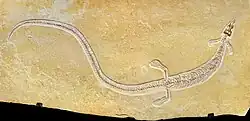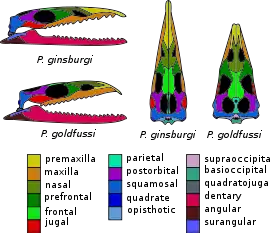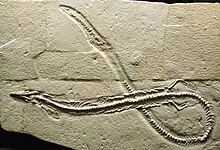Pleurosaurus
Pleurosaurus (from Greek: πλευρᾱ́ pleurā́, 'rib' or 'side' and Greek: σαῦρος saûros, 'lizard') is an extinct genus of aquatic reptiles belonging to the group Sphenodontia, extinct relatives of the modern tuatara. Pleurosaurus fossils were discovered in the Solnhofen Limestone of Bavaria, Germany and the Canjuers lagerstatte near Canjuers, France. It contains two species, P. goldfussi and P. ginsburgi.[1]

| Pleurosaurus Temporal range: Late Jurassic, | |
|---|---|
 | |
| P. sp., National Taiwan Museum | |
| Scientific classification | |
| Domain: | Eukaryota |
| Kingdom: | Animalia |
| Phylum: | Chordata |
| Class: | Reptilia |
| Order: | Rhynchocephalia |
| Family: | †Pleurosauridae |
| Genus: | †Pleurosaurus Meyer, 1831 |
| Type species | |
| †Pleurosaurus goldfussi Meyer, 1831 | |
| Species | |
| |
Pleurosaurus is one of the few known aquatic sphenodontians. Its body was approximately 1.5 metres (4.9 ft) long,[2] and elongated for hydrodynamic streamlining, with comparatively short limbs and a powerful tail. The body was heavily modified from those of other rhynchocephalians, including an elongated triangular skull. It swam via the use of poorly efficient axial undulatory anguilliform locomotion (the movement of the body side to side) in shallow marine environments, and was probably piscivorous.[3] It had only small limbs, which probably did not aid in swimming, and nostrils placed far back on the head, close to the eyes.[4]
History of discovery
Pleurosaurus was first described from the Solnhofen Limestone by Christian Erich Hermann von Meyer in 1834, based on the species Pleurosaurus goldfussi. In 1970 fossils were reported from the lithographic limestones in a quarry near the village of Aiguines in the Canjuers plateau, France. In 1974, Pleurosaurus ginsburgi was described based on MNHN 1983-4-CNJ 67, a mostly complete skeleton found at the Aiguines quarry.[1]
Description
Pleurosaurus goldfussi and Pleurosaurus ginsburgi are distinguished by differing skull proportions, different numbers of presacral vertebrae, and considerably shorter forelimbs on P. ginsburgi.[1]

 P. goldfussi
P. goldfussi P. goldfussi
P. goldfussi P. ginsburgi
P. ginsburgi
References
- Dupret, V. (2004). The pleurosaurs: anatomy and phylogeny. Revue de Paléobiologie, 9: 61-80.
- Michael Benton, Vertebrate Paleontology 2009
- Klein, Nicole; Scheyer, Torsten M. (February 2017). "Microanatomy and life history in Palaeopleurosaurus (Rhynchocephalia: Pleurosauridae) from the Early Jurassic of Germany". The Science of Nature. 104 (1–2): 4. Bibcode:2017SciNa.104....4K. doi:10.1007/s00114-016-1427-3. ISSN 0028-1042. PMID 28005148. S2CID 27133670.
- Palmer, D., ed. (1999). The Marshall Illustrated Encyclopedia of Dinosaurs and Prehistoric Animals. London: Marshall Editions. p. 85. ISBN 1-84028-152-9.